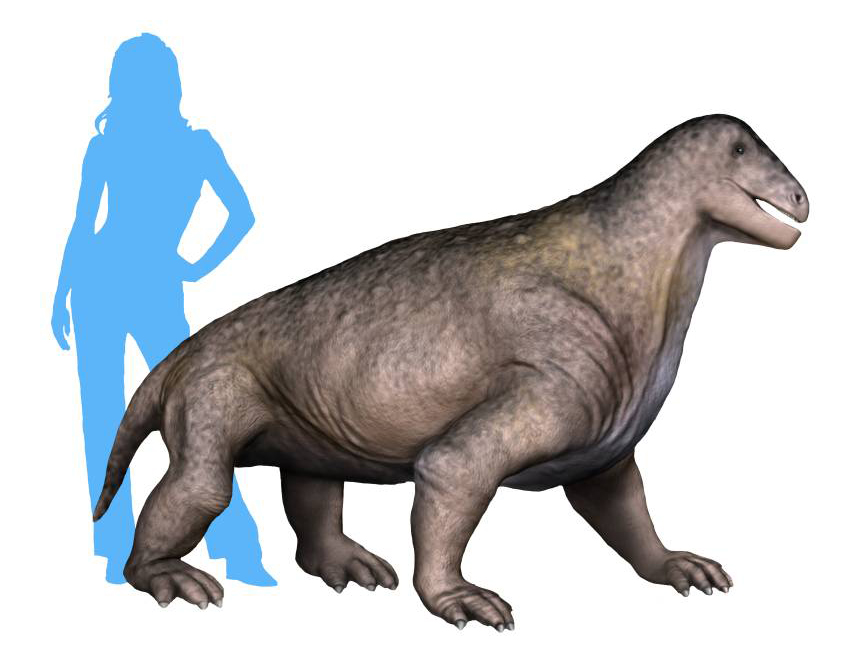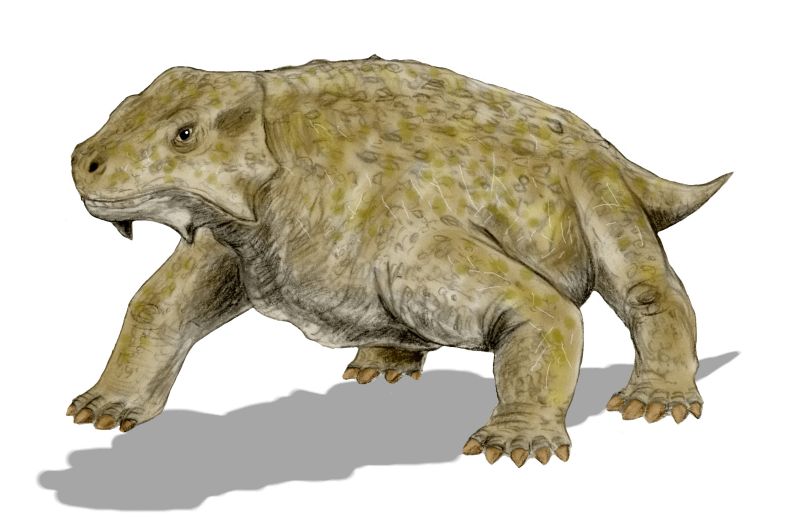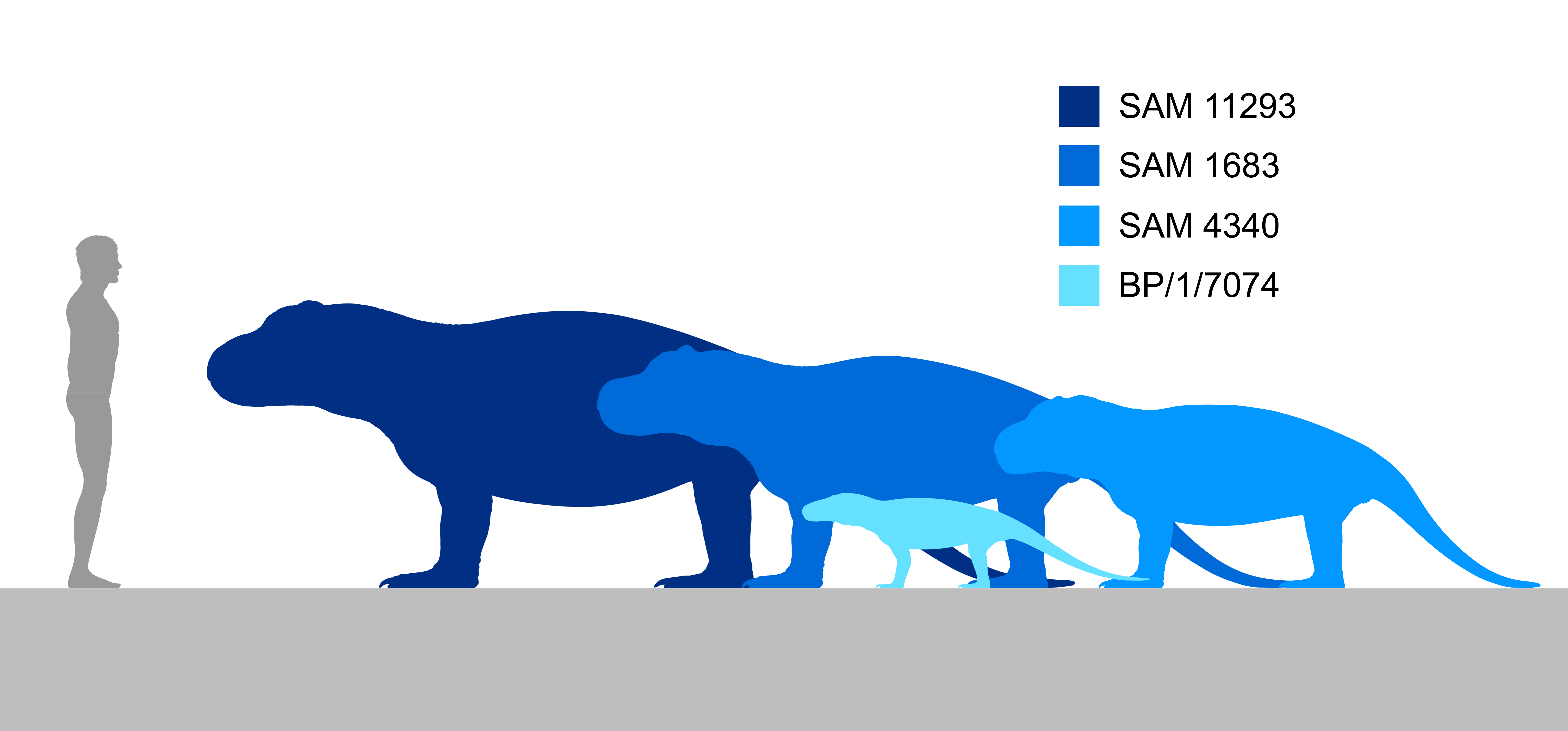|
Dinocephalians
Dinocephalians (terrible heads) are a clade of large-bodied early therapsids that flourished in the Early Permian, Early and Middle Permian between 279.5 and 260 million years ago (Ma), but became extinct during the Capitanian mass extinction event. Dinocephalians included herbivorous, carnivorous, and omnivorous forms. Many species had thickened skulls with many knobs and bony projections. Dinocephalians were the first non-mammalian therapsids to be scientifically described and their fossils are known from Russia, China, Brazil, South Africa, Zimbabwe, and Tanzania. Description Apart from the biarmosuchians, the dinocephalians are the least advanced therapsids, although still uniquely specialised in their own way. They retain a number of primitive characteristics (e.g. no secondary palate, small dentary) shared with their pelycosaur ancestors, although they are also more advanced in possessing therapsid adaptations like the expansion of the ilium (bone), ilium and more e ... [...More Info...] [...Related Items...] OR: [Wikipedia] [Google] [Baidu] |
Permian
The Permian ( ) is a geologic period and System (stratigraphy), stratigraphic system which spans 47 million years, from the end of the Carboniferous Period million years ago (Mya), to the beginning of the Triassic Period 251.902 Mya. It is the sixth and last period of the Paleozoic Era; the following Triassic Period belongs to the Mesozoic Era. The concept of the Permian was introduced in 1841 by geologist Sir Roderick Murchison, who named it after the Perm Governorate, region of Perm in Russia. The Permian witnessed the diversification of the two groups of amniotes, the synapsids and the Sauropsida, sauropsids (reptiles). The world at the time was dominated by the supercontinent Pangaea, which had formed due to the collision of Euramerica and Gondwana during the Carboniferous. Pangaea was surrounded by the superocean Panthalassa. The Carboniferous rainforest collapse left behind vast regions of desert within the continental interior. Amniotes, which could better cope with these ... [...More Info...] [...Related Items...] OR: [Wikipedia] [Google] [Baidu] |
Ulemosaurus
''Ulemosaurus'' is an extinct genus of dinocephalian therapsids that lived 265 to 260 million years ago, at Isheevo in Russian Tatarstan. It was a tapinocephalid, a group of bulky herbivores which flourished in the Middle Permian. ''Ulemosaurus'' and other tapinocephalians disappeared at the end of the Middle Permian. Description Only several partial skeletons and skulls have been found. ''Ulemosaurus'' grew to 4-5 meters in length and weighed up to one ton.https://ar.culture.ru/en/subject/ulemozavr The skull bones are extremely dense: about at its thickest. This thickening is possibly related to head-butting behavior, as some researchers suggest. The species is considered a herbivore, but because the mandible is heavily constructed some palaeontologists consider it a carnivore, with the species being able to use muscle power to cut prey up with its incisors. Classification ''Ulemosaurus'' is a large '' Moschops''-like form from Russia; it is probably similar enough to be ... [...More Info...] [...Related Items...] OR: [Wikipedia] [Google] [Baidu] |
Moschops
''Moschops'' (Greek for "calf face") is an extinct genus of therapsids that lived in the Guadalupian Epoch (geology), epoch, around 265–260 million years ago. They were heavily built plant eaters, and they may have lived partly in water, as hippopotamuses do. They had short, thick heads and might have competed by head-butting each other. Their elbow joints allowed them to walk with a more mammal-like gait rather than crawling. Their remains were found in the Karoo region of South Africa, belonging to the Tapinocephalus Assemblage Zone, ''Tapinocephalus'' Assemblage Zone. Therapsids, such as ''Moschops'', are synapsids, the dominant land animals in the Permian period, which ended 252 million years ago. Description ''Moschops'' were heavy set dinocephalian synapsids, measuring in length, and weighing on average and in maximum body mass. They had small heads with broad Orbit (anatomy), orbits and heavily built short necks. Like other members of Tapinocephalidae, the skull ha ... [...More Info...] [...Related Items...] OR: [Wikipedia] [Google] [Baidu] |
Moschops BW
''Moschops'' (Greek for "calf face") is an extinct genus of therapsids that lived in the Guadalupian epoch, around 265–260 million years ago. They were heavily built plant eaters, and they may have lived partly in water, as hippopotamuses do. They had short, thick heads and might have competed by head-butting each other. Their elbow joints allowed them to walk with a more mammal-like gait rather than crawling. Their remains were found in the Karoo region of South Africa, belonging to the ''Tapinocephalus'' Assemblage Zone. Therapsids, such as ''Moschops'', are synapsids, the dominant land animals in the Permian period, which ended 252 million years ago. Description ''Moschops'' were heavy set dinocephalian synapsids, measuring in length, and weighing on average and in maximum body mass. They had small heads with broad orbits and heavily built short necks. Like other members of Tapinocephalidae, the skull had a tiny opening for the pineal organ. The occiput was broad ... [...More Info...] [...Related Items...] OR: [Wikipedia] [Google] [Baidu] |
Early Permian
01 or 01 may refer to: * The year 2001, or any year ending with 01 * The month of January * 1 (number) Music * '01 (Richard Müller album), ''01'' (Richard Müller album), 2001 * 01 (Urban Zakapa album), ''01'' (Urban Zakapa album), 2011 * ''01011001'', the seventh studio album from Arjen Anthony Lucassen's Ayreon project Other uses * 01 (telephone number), United Kingdom internal dialing code for London between the late 1950s and 1990 * Lynk & Co 01, a compact SUV built since 2017 * Nammi 01, an electric subcompact hatchback * Ji Yue 01, an electric crossover SUV * BAR 01, a Formula One car * Zero One also known as ''Machine City'', a city-state from the ''The Matrix (series), Matrix'' series * Kolmogorov's zero-one law, a law of probability theory * Pro Wrestling ZERO1-MAX, a wrestling promotion formerly known as Pro Wrestling ZERO-ONE * The number of the French department Ain * The codename given to the Wing Gundam by Oz in the anime ''Gundam Wing'' * ''Kamen Rider Zero-One'', ... [...More Info...] [...Related Items...] OR: [Wikipedia] [Google] [Baidu] |
Dentary
In jawed vertebrates, the mandible (from the Latin ''mandibula'', 'for chewing'), lower jaw, or jawbone is a bone that makes up the lowerand typically more mobilecomponent of the mouth (the upper jaw being known as the maxilla). The jawbone is the skull's only movable, posable bone, sharing joints with the cranium's temporal bones. The mandible hosts the lower teeth (their depth delineated by the alveolar process). Many muscles attach to the bone, which also hosts nerves (some connecting to the teeth) and blood vessels. Amongst other functions, the jawbone is essential for chewing food. Owing to the Neolithic advent of agriculture (), human jaws evolved to be smaller. Although it is the strongest bone of the facial skeleton, the mandible tends to deform in old age; it is also subject to fracturing. Surgery allows for the removal of jawbone fragments (or its entirety) as well as regenerative methods. Additionally, the bone is of great forensic significance. Structure ... [...More Info...] [...Related Items...] OR: [Wikipedia] [Google] [Baidu] |
Tapinocephalus
''Tapinocephalus'' ("low, depressed head") is an extinct genus of large herbivorous dinocephalians that lived during the Middle Permian Period in what is now South Africa. Only the type species, ''Tapinocephalus atherstonei'' is now considered valid for this genus. Discovery and naming Fossils of ''Tapinocephalus atherstonii'' were collected and donated to the British Museum by William Guybon Atherstone. They were described by Richard Owen, who described and named the species in 1876. He initially considered it a close relative of ''Pareiasaurus'' and classified both as members of Dinosauria. Based on the only remains of the skull known at the time—a poorly-preserved partial snout—he believed it had a low, broad skull similar to labyrinthodonts. Owen accordingly named it ''Tapinocephalus'', from Greek ταπεινός "low, depressed" and κεφαλή "head". Description These stocky, barrel-bodied animals were characterised by a massive bony skull roof and short weak sn ... [...More Info...] [...Related Items...] OR: [Wikipedia] [Google] [Baidu] |
Pareiasaur
Pareiasaurs (meaning "cheek lizards") are an extinct clade of large, herbivorous parareptiles. Members of the group were armoured with osteoderms which covered large areas of the body. They first appeared in southern Pangea during the Middle Permian, before becoming globally distributed during the Late Permian. Pareiasaurs were the largest reptiles of the Permian, some reaching sizes over , equivalent to the largest contemporary therapsids. Pareiasaurs became extinct in the end-Permian mass extinction event. Description Pareiasaurs ranged in size from long, with some species estimated to exceed in body mass. The limbs of many parieasaurs were extremely robust, likely to account for the increased stress on their limbs caused by their typically sprawling posture. The cow-sized '' Bunostegos'' differed from other pareiasaurs by having a more upright limb posture, being amongst the first amniotes to develop this trait. Pareiasaurs were protected by bony scutes called osteoderms ... [...More Info...] [...Related Items...] OR: [Wikipedia] [Google] [Baidu] |
Caseidae
Caseidae are an Extinction, extinct Family (biology), family of Basal (phylogenetics), basal synapsids that lived from the Late Carboniferous to Middle Permian between about 300 and 265 million years ago. Fossils of these animals come from the south-central part of the United States (Texas, Oklahoma, and Kansas), from various parts of Europe (European Russia, France, Germany, Sardinia, and Poland), and possibly from South Africa if the genus ''Eunotosaurus'' is indeed a caseid as some authors proposed in 2021. Caseids show great Taxonomy, taxonomic and morphological diversity. The most basal taxa were small Insectivore, insectivorous and Omnivore, omnivorous forms that lived mainly in the Upper Carboniferous and Lower Permian, such as ''Eocasea'', ''Callibrachion'', and ''Martensius''. This type of caseid persists until the Guadalupian, middle Permian with ''Phreatophasma'' and may be ''Eunotosaurus''. During the early Permian, the clade is mainly represented by many species that a ... [...More Info...] [...Related Items...] OR: [Wikipedia] [Google] [Baidu] |
Anteosaurus
''Anteosaurus'' (meaning "Antaeus lizard") is an extinct genus of large carnivorous dinocephalian synapsid. It lived at the end of the Guadalupian (= Middle Permian) during the Capitanian age, about 265 to 260 million years ago in what is now South Africa. It is mainly known by cranial remains and few postcranial bones. Measuring long and weighing about , ''Anteosaurus'' was the largest known carnivorous synapsid, non-mammalian synapsid and the largest terrestrial predator of the Permian period. Occupying the top of the food chain in the Middle Permian, its skull, jaws and teeth show adaptations to capture large prey like the giants Titanosuchidae, titanosuchids and Tapinocephalidae, tapinocephalids dinocephalians and large Pareiasauromorpha, pareiasaurs. As in many other dinocephalians the cranial bones of ''Anteosaurus'' are pachyostosis, pachyostosed, but to a lesser extent than in tapinocephalid dinocephalians. In ''Anteosaurus'', pachyostosis mainly occurs in the form of hor ... [...More Info...] [...Related Items...] OR: [Wikipedia] [Google] [Baidu] |
Semiaquatic
In biology, being semi-aquatic refers to various macroorganisms that live regularly in both aquatic and terrestrial environments. When referring to animals, the term describes those that actively spend part of their daily time in water (in which case they can also be called amphibious), or land animals that have spent at least one life stages (e.g. as eggs or larvae) in aquatic environments. When referring to plants, the term describes land plants whose roots have adapted well to tolerate regular, prolonged submersion in water, as well as emergent and (occasionally) floating-leaved aquatic plants that are only partially immersed in water. Examples of semi-aquatic animals and plants are given below. Semiaquatic animals Semiaquatic animals include: * Vertebrates ** Amphibious fish; also several types of normally fully aquatic fish such as the grunion and plainfin midshipman that spawn in the intertidal zone ** Some amphibians such as newts and salamanders, and some fr ... [...More Info...] [...Related Items...] OR: [Wikipedia] [Google] [Baidu] |
Jonkeria
''Jonkeria'' is an extinct genus of dinocephalians. ''Jonkeria'' was a large and omnivore, omnivorous animal, from the Tapinocephalus Assemblage Zone, ''Tapinocephalus'' Assemblage Zone, Lower Beaufort Group, of the South Africa, South African Karoo. Description The overall length was or more (up to ), the skull about 55 cm long. The skull is nearly twice as long as wide, and the snout is elongated and provided with sharp incisors and large canine tooth, canines. The cheek teeth were small. The body is robustly built, and the limbs stout. ''Jonkeria'' cannot be distinguished from its relative ''Titanosuchus'' on skull, cranial grounds, but only in limb length; ''Jonkeria'' having short and squat limbs, and ''Titanosuchus'' long ones. The limb and rib bones of ''Jonkeria'' display thickened bone walls and infilling of the medullary cavity with bone tissue. This is similar to the bone structure of the modern hippopotamus and the extinct aquatic reptile ''Claudiosaurus'', an ... [...More Info...] [...Related Items...] OR: [Wikipedia] [Google] [Baidu] |









